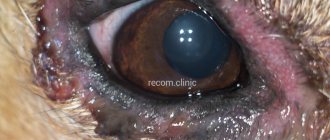When a person adopts a dog, he takes full responsibility for its future. This is not only about proper nutrition and regular walks, it also means assistance in the treatment and prevention of diseases. It should be noted that dog diseases, the symptoms of which are varied and numerous, have become a common cause of premature death in dogs in recent years. The problem with dog diseases is that a pet, unlike a person, cannot tell others what hurts and where it hurts, so the owner is called upon to treat the pet with trepidation and increased attention.
General information about dog diseases
Main groups of diseases:
- endocrine diseases;
- infectious diseases;
- diseases of the circulatory system;
- diseases of the mouth, ear, nose and throat;
- eye diseases;
- skin diseases;
- diseases of the digestive system;
- diseases of the musculoskeletal system.
Endocrine diseases arise from various disruptions in the functioning of endocrine glands that do not have excretory ducts, releasing hormones directly into the blood.
These glands include the thyroid gland, pineal gland, pituitary gland, parathyroid glands, thymus gland, adrenal glands, gonads and secretory parts of the pancreas. Endocrine diseases in dogs can occur in two forms: with an increase in the amount of hormones released into the blood and with a decrease. Such diseases are difficult to diagnose; pets are often diagnosed in the final stages, when there is very little chance of curing the dog. Infectious diseases are associated with the direct entry of a pathogenic microbe into the pet’s body. Let us note that infection and development of the infectious process is possible only if the dog’s body is susceptible to the microbe. Otherwise, nothing will happen.
Therefore, dogs with weakened immune systems, puppies and old dogs get sick. Sometimes an infectious process is layered on top of another, which aggravates the course of each disease. In the vast majority of cases, diseases occur quickly and threaten the dog with death. Spread through the air or through direct contact. There are frequent cases of epidemics among dogs.
Diseases of the circulatory system are divided into heart diseases and blood vessel diseases. Typically observed in adult dogs.
Diseases of the ear, throat, nose and mouth are divided into traumatic, infectious and inflammatory diseases. Similar diseases occur in dogs more often than others; these organs are the first to come into direct contact with various agents. The complexity of such diseases lies in their secrecy: in the initial stages, identifying the disease is problematic, the dog does not show signs of the disease.
Eye diseases are not uncommon among dogs, but are observed in adult pets. The main eye diseases include cataracts (clouding of the lens), iridocyclitis (inflammation of the iris and ciliary body), keratitis (inflammation of the cornea) and conjunctivitis (inflammation of the conjunctiva).
Skin diseases differ according to the causes of occurrence and the location of the pathological focus (on the skin, in the hair, on visible mucous membranes).
Diseases of the digestive system are the result of improper and irrational feeding of the dog, although sometimes the cause of such diseases is banal poisoning with bad water or food.
Diseases of the musculoskeletal system are considered especially dangerous after the age of 8 years and during puppyhood. With such diseases, the body suffers: the dog’s bones, internal organs.
It should be noted that kidney diseases, in particular urolithiasis and liver diseases, are considered common pathologies among dogs. It is important to know the symptoms of distemper, which is sometimes called canine distemper.
Prevention
For all the diseases listed above, the main preventive measures are timely vaccinations and vaccinations . Thanks to annual procedures, dogs develop strong immunity, and as a result, the risk of infection is reduced several times.
You also need to take into account the fact that the causative agents of some fatal diseases remain active for about 90 days after the carrier is cured. Therefore, you need to exclude your pet from contact with animals that have recently suffered from similar diseases.
The main role in detecting the primary signs of any disease is assigned to the dog owner. The next step, no less important, is an urgent visit to a veterinary center, where they will conduct the necessary studies and make an accurate diagnosis and prescribe treatment. If you notice your pet is unwell, you shouldn’t hope that the problem will go away on its own. Self-treatment is also dangerous! Such negligence leads to disastrous consequences and the death of the dog.
Dog diseases: distemper - symptoms
Distemper in dogs is a viral disease characterized by damage to the skin, digestive and respiratory organs; in rare cases, the development of meningitis and encephalitis is noted. The virus affects dogs of all ages, although dogs between one month and two years of age are predominantly affected. Even marine animals are susceptible to the disease. Terriers and boxers are considered relatively resistant to canine distemper; humans do not get sick.
Clinical signs of plague are varied:
Asymptomatic virus carriage or a lightning-fast, violent course occurs. The duration of the disease can range from several days or weeks to several months. When the clinical picture of the disease is dominated by symptoms of damage to the respiratory system, they speak of a pulmonary form of the disease, when the nervous system is extensively affected, they speak of a nervous form. This division is arbitrary; symptoms of damage to the digestive organs often prevail in the clinical picture. Sometimes there is a combination of damage to the respiratory system and skin, the nervous system becomes the final stage of the development of the disease.
Canine distemper begins to manifest itself with the appearance of a pustular or macular rash on the inner surfaces of the thighs, with a runny nose, diarrhea, depression of consciousness, temporary refusal to feed, and redness of the conjunctiva. As a rule, there is an increase in body temperature, although, for example, in dwarf poodles or some other breeds of dogs, the plague occurs against a background of normal temperature. At the same time, the animal hides in dark places and refuses to walk. The dog's skin becomes dry.
It is possible to develop hyperkeratosis on the elbows and small focal baldness. There are discharges from the nose, which are transparent in the first stages of the development of the disease, but become mucopurulent over time. Sometimes there is clouding of the cornea, sticking or redness of the eyelids, shortness of breath appears, and wheezing is heard. The intestinal form of the disease is characterized by the development of diarrhea and vomiting.
Symptoms of damage to the nervous system include the appearance of tics, which begin in the muscles of the head. At the first stages it is not intense, but later it spreads to the limbs and becomes pronounced, as a result the animals do not sleep at night and often whine. Paralysis, paresis, and hyperkinesis gradually develop. At the last stage, meningoencephalitis develops, which is accompanied by severe intoxication and ends in death.
Treatment is prescribed only by a veterinarian.
Rabies
This is the most dangerous disease in pets, during which the nervous system is damaged, which irreversibly leads to death. The pathogen is transmitted from animal to animal or from animal to human through blood and saliva. The duration of the incubation period can range from 2-3 weeks to 2-3 months.
Symptoms of rabies differ depending on the form. It looks like this:
- Exuberant form. This form is characterized by lethargy, anxiety, and an aggressive attitude towards people. The pet does not eat or drink anything, as the sick animal has a spasm of the swallowing muscles. After this, drooling is observed, muscles and vital organs are paralyzed. Paralysis is fatal.
- Paralytic or mild form. With this form, the pet becomes gentle and affectionate, spending all the time next to the owner. The dog's lower jaw droops, salivation increases, and it is difficult for the dog to eat and drink.
- Atypical. The name of the form comes from the fact that the disease is accompanied by symptoms of gastritis and enteritis, which significantly complicates diagnosis.
There is currently no treatment for rabies. If a sick animal is discovered, it is euthanized.
The only preventive measure is vaccination from a veterinarian.
Liver disease in dogs: symptoms
Liver diseases in dogs can occur in acute or chronic form. In recent years, there has been an increase in the number of diagnosed liver diseases in dogs, which is directly related to violations of the feeding regime of pets and the widespread prevalence of autoimmune diseases. Sometimes the cause of liver disease in dogs is iatrogenic lesions (caused by a veterinarian).
Symptoms of liver disease in dogs are conventionally divided into a number of syndromes, among which are usually distinguished:
- cholestatic syndrome;
- cytolytic syndrome;
- mesenchymal inflammatory syndrome;
- hemorrhagic syndrome;
- dyspeptic syndrome;
- portal hypertension syndrome;
- hepatolienal syndrome;
- hepatodepressive syndrome;
- liver shunt syndrome.
Cholestatic syndrome involves a violation of the secretion and release of bile, which is manifested by skin itching, jaundice, a tendency to eczematous skin lesions, and stool discoloration.
Cholestatic syndrome is a consequence of the destruction of liver cells and leads to fever (increased temperature), enlargement and tenderness of the liver, and an increase in liver enzymes is observed in blood tests.
Mesenchymal-inflammatory syndrome is characterized by damage to the stroma and mesenchyme of the liver, which is manifested by an increase in the level of immunoglobulins.
Hemorrhagic syndrome is manifested by various bleedings and hemorrhages, anemia.
Portal hypertension syndrome is manifested by an increase in the size of the abdomen and dilation of the veins on the skin of the abdomen.
Dyspeptic syndrome is manifested by lethargy, depression, vomiting, defecation disorders and weight loss.
Hepatolienal syndrome is manifested by an enlargement of the liver and spleen.
Hepatodepressive syndrome is manifested by a violation of the protein-synthesizing, antitoxic and excretory functions of the liver; the symptoms are very numerous.
Liver shunt syndrome allows life-threatening substances to enter the dog's general bloodstream, causing damage to the central nervous system.
Symptoms of kidney disease in dogs
Kidney diseases are reported more often in dogs than in other animals, and their frequency increases over the years. According to scientists, in dogs over 8 years of age, in almost fifty percent of cases, pronounced symptoms of kidney damage are revealed during studies. With histological examination, the number increases to eighty percent.
The main syndromes of kidney damage include:
- nephrotic syndrome;
- uremic syndrome;
- pain syndrome;
- osteorenal syndrome;
- renal eclampsia syndrome.
Pain syndrome is manifested by the dog's desire to lie in a cold place, frequent arching of the back, the need for frequent urination, pain when urinating, soreness of the back muscles (can be checked by pressing with fingers), swelling and transient paresis.
Nephrotic syndrome is manifested by edema, proteinuria, hypoproteinemia, oliguria and cylindruria, detected during laboratory tests.
Uremic syndrome is manifested by apathy, lack of appetite, vomiting, persistently recurrent diarrhea, urine odor from the mouth, anemia and anuria.
Osteorenal syndrome is characterized by bone deformation and osteoporosis, hypocalcemia and osteodystrophy.
Renal eclampsia syndrome manifests as tonic-clonic seizures, nephrotic syndrome, and episcleral vascular injection (red eyes).
Urolithiasis in dogs: symptoms
Urolithiasis in dogs is a disease characterized by the formation of stones in the kidneys, bladder or their retention in the ureters or urethra.
This disease is considered a relatively rare disease for dogs, in contrast to cats, in which urolithiasis is often recorded. It is common for dogs to develop bladder stones.
Predisposing factors to the development of urolithiasis in dogs are:
- age (usually found in dogs aged 2-8 years);
- gender (occurs equally often in both sexes, urethral obstruction occurs more often in males);
- breed (large breeds are less susceptible to the disease than small ones);
- diet (food rich in protein, phosphorus, magnesium, calcium provokes the development of the disease);
- indoor maintenance and exercise (the list includes infrequent walks, a small amount of water in the bowl and low physical activity).











